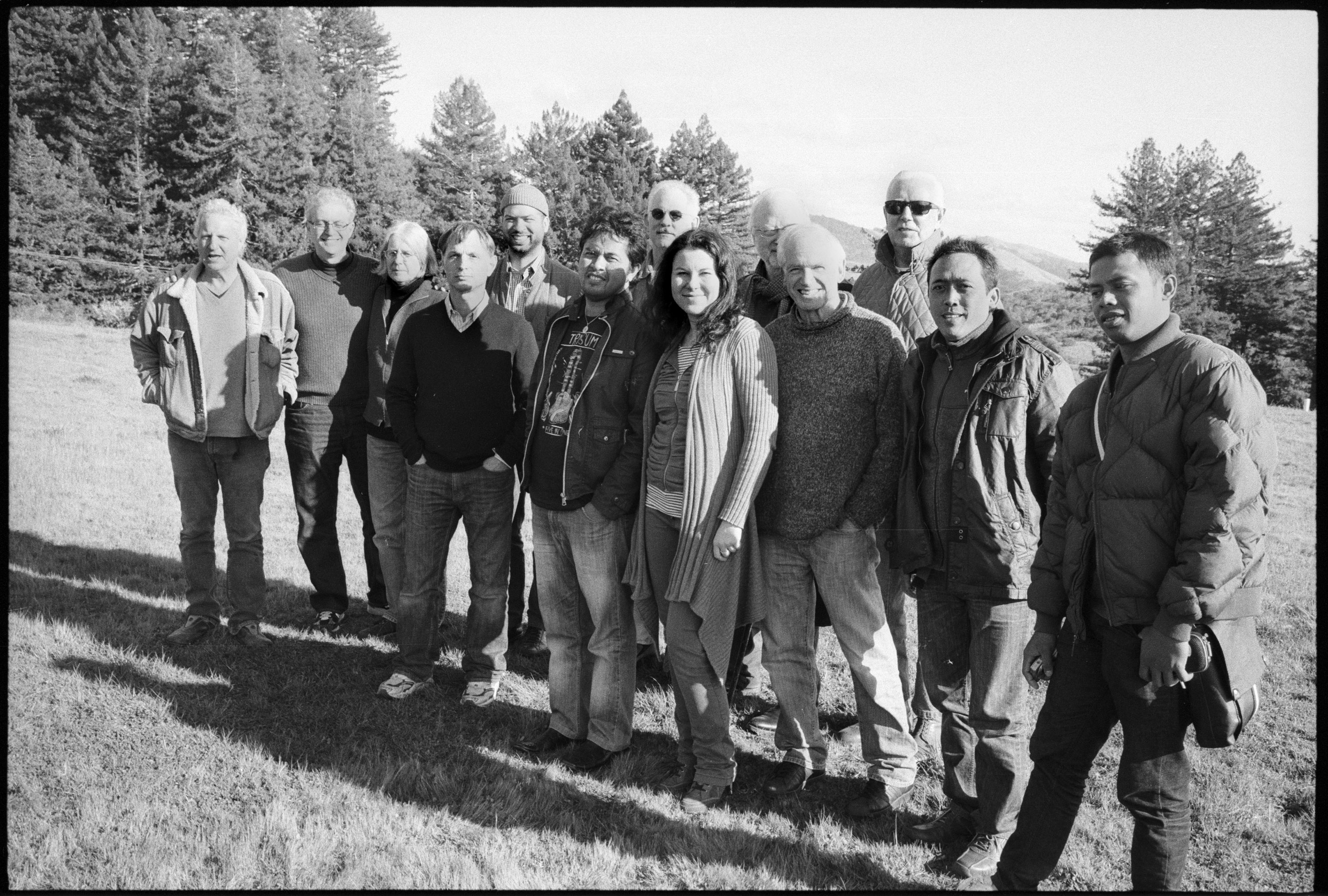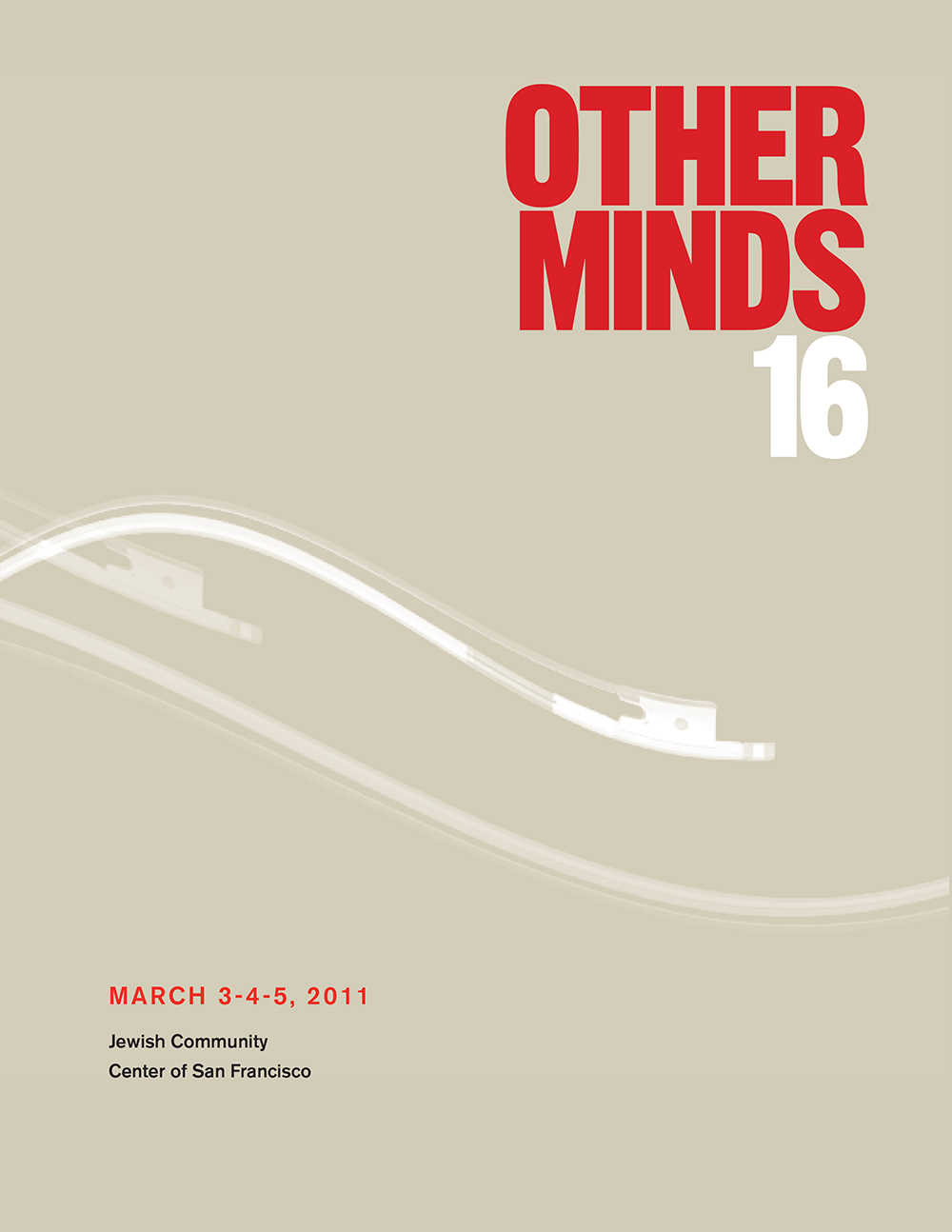
Other Minds Festival 16 cast its nets very broadly brought together an eclectic group of composers from all over the world: Southeast Asia, Europe, and the US. Not only geographically diverse, but style-wise, age-wise, and they couldn’t have been more widely varied.
In May 2010, Charles Amirkhanian traveled to Bali and met I Wayan Balawan, one of the legendary jazz and popular musicians of Indonesia. He accepted the invitation to appear at OM 15 and to introduce his two-neck two-hands style of guitar playing to San Francisco on his first trip to the United States.
We were very pleased to have had Louis Andriessen as guest—a brilliant composer and teacher whose influence and reputation has spread very far beyond his roots in his native Holland. Andriessen’s music is anti-Germanic and anti-Romantic, and marks a departure from post-war European serial music and its descendants. Also from the Netherlands, Han Bennink, the virtuoso percussionist, was a part of the group and performed with the brilliant guitarist, Fred Frith
Keyboardist and composer Jason Moran wrote a new suite of pieces titled Slang, commissioned by Other Minds for his ensemble Bandwagon. OM also commissioned David A. Jaffe to write music for double string quartet and robotic percussion that made use of new instruments designed by Trimpin and spatially located around the audience.
Ever since the premiere in 2004 of Janice Giteck’s Ishi, the composer had yearned for a performance here in the Bay Area of this touching tribute to the last American Indian living independently in Northern California. We were delighted to welcome this protégé of Darius Milhaud and Olivier Messiaen back home from Seattle where, for many years, she taught hundreds of young composers at the Cornish College of the Arts.
Agata Zubel, a young composer vocalist/composer from Poland made her US debut. Zubel is a graduate of Wrocław’s Karol Szymanowski High School of Music and the Karol Lipiński University of Music, where she studied composition with Jan Wichrowski. She is a member of the Youth Circle of the Polish Composers’ Union and a recipient of the Ministry of Culture and National Heritage scholarship.
Kyle Gann is the kind of composer and commentator on new music whose inspiration seems to flow from a wildcat Texas oilwell. Thankfully, nobody—not even he—has found a way to cap his emissions, and his widely-read blog PostClassic continues to gush unpredictable observations. His two cd, microtonal extravaganza, Hyperchromatica, was released by Other Minds Records in 2018.
The festival opened with a 75th birthday tribute to retired composer and proactive raconteur Anthony J. Gnazzo who studied theory at the Hartt School of Music, mathematics at the University of Hartford and theory with Krenek, Berger, and Shapero at Brandeis University. His compositions include text-sound pieces, electronic scores, environmental pieces, kinetic sculpture, and whose setting of the Star Spangled Banner is rivaled only by that of Igor Stravinsky.
Artist Bios
2011 Grawemeyer Award winner Louis Andriessen was born in Utrecht in 1939 and studied composition with, among others, Luciano Berio. From a background of jazz and avant-garde composition, he evolved a style employing elemental harmonic, melodic and rhythmic materials, heard in totally distinctive instrumentation. His acknowledged admiration for Stravinsky is illustrated by a parallel vigor, clarity of expression, and acute ear for color. Groups who have commissioned or performed his works include the San Francisco Symphony, BBC Symphony, Kronos Quartet, Ensemble Modern, Bang On A Can All-Stars, and the California EAR Unit. Among his collaborative works are a series of dance projects; the theater piece De Materie, created with Robert Wilson; and two stage works and a film by Peter Greenaway. Nonesuch Records has released a series of recordings of Andriessen’s major works.
I Wayan Balawan (b. 1973, Bali) grew up with the traditional gamelan music of Bali, but from an early age preferred rock music, gravitating to such bands as the Scorpions, Deep Purple, and the Beatles. He taught himself to play guitar at the age of 8, and after enjoying rock in his adolescence he decided to study jazz at the Australian Institute of Music in Sydney. After graduating from the Institute, he returned to Bali in 1997 and formed a band called Batuan Ethnic Fusion, which combined Balinese gamelan music with a jazz/fusion style. Balawan plays a special guitar with two necks made by Julius Salaka. There are six strings on the guitar’s upper neck and seven strings on the lower neck, which utilizes MIDI pickups to trigger synths and samplers. He has made three recordings as a soloist and others with various ensembles.
Born near Amsterdam in 1942, Han Bennink‘s first instrument was a kitchen chair. Though he ultimately came to excel on a number of instruments, including soprano saxophone, trombone, clarinet and others, he is primarily known as a percussionist and drummer. In the early part of his career, he played with many jazz greats on their European tours – such artists as Eric Dolphy, Sonny Rollins, Ben Webster, Dexter Gordon and Wes Montgomery – and at the same time started to develop his own style as part of the Instant Composers Pool, a musicians collective formed in 1967. Through the latter part of the 20th century he performed in small ensembles with a great many players from both Europe and the U.S. – Steve Lacy, George Lewis, Dave Douglas, Roswell Rudd, Ray Anderson and Johnny Griffin among them. He has recorded frequently throughout his career as both leader and sideman. He now fronts his own trio, which includes clarinettist Joachim Badenhorst and pianist Simon Toldam. Since attending art school as a young man, Bennink has also pursued a successful parallel career as an artist in several media, and has designed many of the covers of the Land CDs on which he appears. He is represented by Amsterdam’s Galerie Espace.
Kyle Gann (b.1955, Dallas) has achieved success as both composer and music critic for decades. He studied composition with Ben Johnston, Morton Feldman and Peter Gena, and his music is often microtonal, using up to 37 pitches per octave. His rhythmic language, based on differing successive and simultaneous tempos, was developed from his study of Hopi, Zuni, and Pueblo Indian musics. His major works, including a piano concerto, music theater, choral works, microtonal chamber operas and solo piano compositions, have been performed by prominent ensembles worldwide. He was new music critic for the Village Voice for 20 years and is the author of The Music of Conlon Nancarrow, American Music in the 20th Century, No Such Thing as Silence: John Cage’s 4’33”, and Robert Ashley. Since 1997 he has taught music theory, history and composition at Bard College and has also lectured at Columbia University, the School of the Art Institute of Chicago, and Bucknell University. For his music criticism, he has received the Peabody Award (2003), the Stagebill Award (1999) and the Deems- Taylor Award. His music is available on the New Albion, New World, Cold Blue, Lovely Music, Mode, Meyer Media, New Tone, and Monroe Street labels.
Now based in Seattle, Janice Giteck (b.1946, New York) was raised in Tucson from the age of 12, and attended Mills College. Among her teachers were Darius Milhaud, Olivier Messiaen, and in studies of Indonesian gamelan music, Daniel Schmidt. Greatly influenced by Native American music, her compositions are in turn rhythmic and meditative, ritualistic and serene. Ms.Giteck’s works strive to recapture the ancient musical attributes of ritual and trance, exploring ways in which music can be a truly healing experience. Though she is of Russian Jewish heritage and has explored Judaism’s mystical Kabala, her natural eclecticism and curiosity have drawn her to many cultures and she has learned from them all. She has received commissions, grants and awards from such organizations as Meet the Composer , the National Endowment for the Arts, the Fromm Foundation and the San Francisco Symphony. She has written music for two films by Pat Ferrero. Giteck also holds a degree in psychology.
David A. Jaffe (b.1955, New Jersey) studied violin, mandolin, and composition from an early age, then attended the Ithaca College School of Music, Bennington College, and received his DMA in composition from Stanford University. He has taught at Princeton, UCSD, and Stanford, and has lectured widely in Europe, Japan, the Americas and Australia. His musical language is at once personal and audacious, drawing on pop music elements, with aesthetic roots in the music of Charles Ives, Carl Ruggles, and Henry Brant. His “maximalist” approach extends to extra-musical material as well, with elements ranging from birdsong to politics and social justice. Jaffe’s technical innovations date back to the early 1980s, when he developed a breakthrough technique for plucked string synthesis, in collaboration with Alex Strong, Kevin Karplus and Julius Smith. He has continued to explore his interests in physical modeling and software design as part of the Sondius/SynthBuilder project. His compositions have been commissioned by such ensembles as the Kronos Quartet, the American Guild of Organists, and the Mostly Modern Orchestra. Recordings of his music can be found on Elektra/Asylum, Wergo, CDCM/Centaur, Vienna Modern Masters, and Well-Tempered. His writings on music have been published extensively in prominent music journals.
Pianist and 2010 MacArthur Fellow Jason Moran (b.1975, Houston) and his group The Bandwagon (bassist Tarus Mateen and drummer Nasheet Watts) have challenged the status quo in so many arenas – improvisation, composition, group concept, repertoire, technique and experimentation – that they have been called the “future of jazz.” The Blue Note Records recording artist has established himself as a risk-taker and innovator of major proportions. Moran’s debut recording as a leader, Soundtrack to Human Motion, was released in 1999 to tremendously enthusiastic response. Ben Ratliff of the New York Times named it Best Album of the Year, and the Jazz Journalists Association awarded it “Best Debut Recording.” In the ensuing 12 years, Moran has garnered extravagant critical praise as he has released one innovative recording after another, gathering awards as he goes along. Drawing inspiration not only from musical heroes like Thelonious Monk, Moran frequently channels energy from favorite artists like Jean-Michel Basquiat, Egon Schiele and Robert Rauschenberg. He has received commissions from the Walker Art Center, the Dia Art Foundation and Jazz at Lincoln Center. He has lectured at Yale University, Dartmouth University, and the Eastman School of Music, and is on the faculty of the Manhattan School of Music.
Agata Zubel (b.1978, Wroclaw) graduated with honors Primus Inter Pares from the Karol Lipinski Academy of Music, where she studied composition with Jan Wichrowski and Danuta Paziuk-Zipser. She has enjoyed as much acclaim for her singing as her composing, and frequently performs her own music. She has won several competitions, for both voice and composition. In 2005, she received the prestigious Passport of Polityka award for classical music. In the same year, her second symphony – commissioned by Deutsche Welle – was premiered during the Beethoven Festival in Bonn. She has performed extensively throughout Europe, Canada and the U.S. She is featured on two CDs recently released by CD Accord: Cascando, with her own chamber music, and Poems, with the songs of Copland, Berg and Szymanski. She is a member of the Polish Composers’ Union and is on the faculty of the Academy of Music in Wroclaw. Her motto is “At the beginning there was rhythm and colour”!
Festival Program
Thursday, March 3, 2011
7:00 pm Panel Discussion, 8:00 pm Concert, Kanbar Hall, JCCSF
Anthony Gnazzo
Hymn (1975)
pre-recorded
Kyle Gann
Triskaidekaphonia I (2005)
Aron Kallay, keyboard sampler
Louis Andriessen
Le Voile de bonheur (1971)
Monica Germino, voice/violin
Louis Andriessen, piano
Kyle Gann
Kierkegaard, Walking (2007)
flute, clarinet, violin, cello
Seattle Chamber Players
Louis Andriessen
Zilver (1994)
flute, clarinet, percussion (2), piano, violin, cello
Seattle Chamber Players, Loren Mach, Joel Davel, Eric Zivian
Agata Zubel
Cascando (2007) (text by Samuel Beckett)
voice, flute, clarinet, violin, cello
Zubel, Seattle Chamber Players
Janice Giteck
Ishi (2004) (last movement features film by Emiko Omori)
flute, clarinet, violin, cello
Seattle Chamber Players
Friday, March 4, 2011
7:00 pm Panel Discussion, 8:00 pm Concert, Kanbar Hall, JCCSF
David Jaffe
The Space Between Us (2011) (world premiere)
percussion w/ RadioDrum (marimba, glock, chimes, disklavier),
violin (4), viola (2), cello (2)
Andrew Schloss, Del Sol String Quartet, Left Coast Chamber Ensemble
Commissioned by Other Minds, with support from the James Irvine Foundation
and the Canada Council for the Arts
I Wayan Balawan
(set TBD)
electric guitars
Balawan, I Nyoman Suarsana, I Nyoman Suwida, drummer TBD, bassist TBD
Agata Zubel
Parlando (2000)
voice, electronics
Zubel
Han Bennink
(improv set)
percussion, electric guitar
Bennink, Fred Frith
Saturday, March 5, 2011
7:00 pm Panel Discussion, 8:00 pm Concert, Kanbar Hall, JCCSF
Louis Andriessen
Xenia (2005)
Monica Germino, voice/violin
Louis Andriessen
Passeggiata in Tram in America e Ritorno (1998)
voice, violin, piano
Cristina Zavalloni, Germino, Eric Zivian
Letter from Cathy (2003)
voice, violin, harp, percussion, piano, contrabass
Zavalloni, Germino, Zivian
(improv) (2010)
voice, piano
Zavalloni, Andriessen
Kyle Gann
Time Does Not Exist (2000)
piano
Sarah Cahill
Jason Moran
Slang (2011) (commissioned by Other Minds)
piano, bass, drums
Moran, Tarus Mateen, Nasheet Waits, Mary Halvorson, Alicia Hall Moran
Click here to download a PDF copy of the Other Minds Festival 16 program.
Selected Festival Video
Dutch percussion master Han Bennink loosening up backstage before his performance at Other Minds Festival 16 with guitarist Fred Frith. Filmed and edited by Henry Kaiser.
Improvised music by Han Bennink (percussion) and Fred Frith (guitar). Recorded on Friday, March 4, 2011 at the Jewish Community Center of San Francisco, during Other Minds Festival 16.
Letter From Cathy (2003), a composition by Louis Andriessen. Recorded on Saturday, March 5, 2011 at the Jewish Community Center of San Francisco, during Other Minds Festival 16.




